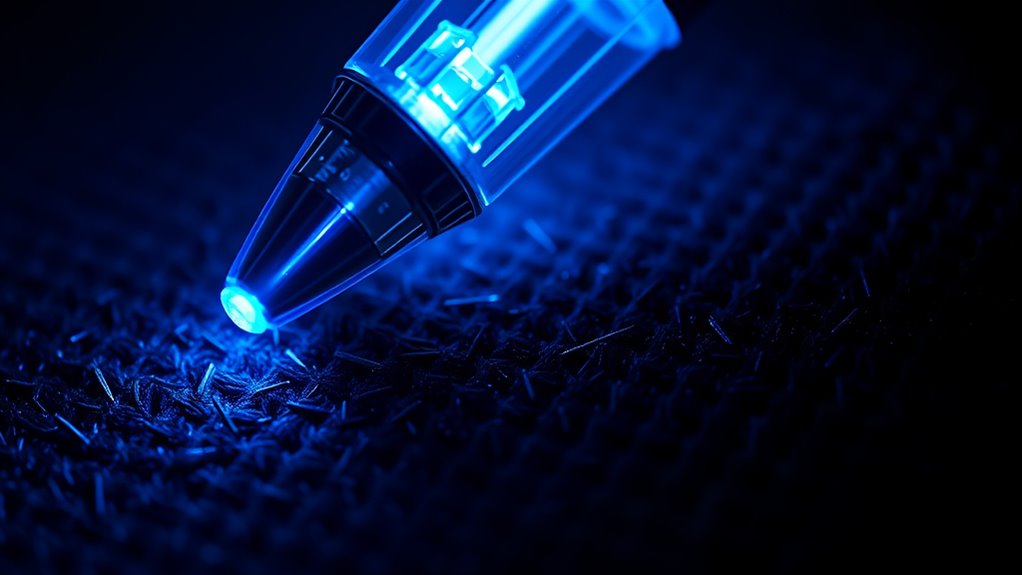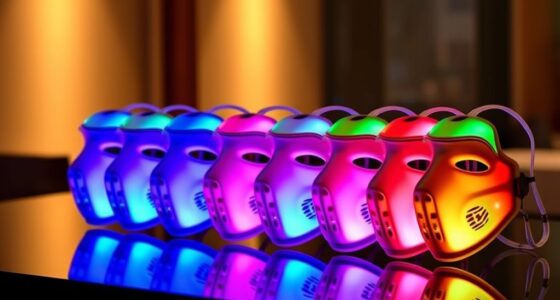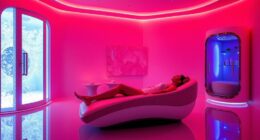The truth about LED penetration depths is that it largely depends on the light’s wavelength, tissue properties, and power levels. Shorter wavelengths like blue and green typically only reach surface layers, while red and near-infrared can penetrate deeper into tissues. Factors like tissue density, pigmentation, and water content also influence how far light travels. To get the most effective results, understanding these details is key—there’s more to uncover if you keep exploring.
Key Takeaways
- Longer wavelengths like red and near-infrared penetrate deeper into tissue than blue or green light.
- Tissue properties such as pigmentation and density significantly influence how deeply LED light travels.
- Increasing power or exposure time can enhance penetration but must be balanced for safety.
- Wavelength selection should match the target tissue depth for effective LED-based treatments.
- Advances in light delivery technology improve penetration efficiency and treatment precision.

LED penetration depths refer to how deeply light from a Light Emitting Diode can travel into materials or tissues. This concept is vital when you’re considering LED applications in medical treatments, industrial processes, or even cosmetic procedures. The depth the light reaches depends on several factors, including the wavelength of the LED, the properties of the material or tissue, and the intensity of the light emitted. Understanding these factors helps you determine whether a specific LED device will be effective for your intended purpose.
LED penetration depth depends on wavelength, tissue properties, and light intensity, affecting medical, industrial, and cosmetic applications.
You’ll find that shorter wavelengths, such as blue and ultraviolet light, tend to have shallow penetration depths. They’re absorbed quickly by superficial layers, making them suitable for surface treatments like skin disinfection or surface sterilization. Conversely, longer wavelengths, including red and near-infrared light, can penetrate deeper into tissues. This characteristic makes them valuable for therapies aimed at stimulating cellular activity or promoting tissue regeneration. When selecting an LED for a particular application, you should consider the target depth to guarantee the light reaches the necessary layers.
The tissue’s composition plays a significant role in how far the light travels. Denser or more pigmented tissues absorb and scatter light more effectively, reducing penetration depth. For example, melanin in the skin absorbs visible light, limiting how deeply wavelengths like blue or green can penetrate. Similarly, fat and water content influence how infrared light travels through tissues. If your goal is to reach deeper structures, you’ll need to choose an LED with a wavelength optimized for minimal absorption and scattering in the target tissue.
Power density and duration of exposure also impact effective penetration. Increasing the intensity or extending exposure times can compensate for some loss of light as it travels inward, but this must be balanced carefully to avoid tissue damage or overheating. Proper calibration ensures that enough light reaches the target area without adverse effects. You should always consider the safety limits and recommended dosages established for your specific application.
Additionally, advancements in light delivery technologies are continually improving the efficiency of light penetration, enabling more precise targeting of tissues while minimizing collateral damage.
Frequently Asked Questions
How Does LED Color Affect Penetration Depth?
You should know that LED color markedly impacts penetration depth because different wavelengths penetrate tissues differently. Blue and green LEDs have shorter wavelengths, so they don’t go as deep, mainly affecting surface layers. In contrast, red and near-infrared LEDs have longer wavelengths, allowing them to penetrate deeper into tissues. This variation makes specific LED colors more suitable for either superficial or deeper treatments, depending on your needs.
Can LED Penetration Depths Vary Between Different Materials?
Yes, LED penetration depths vary between different materials. You might picture shining a flashlight through a dense fog versus clear glass; the light behaves differently. In denser or more reflective materials, LEDs struggle to penetrate deeply, while in softer, more porous ones, they go further. Factors like material composition, density, and absorption rates influence how deeply LED light can effectively reach, making each application unique.
What Factors Influence the Accuracy of Penetration Depth Measurements?
You influence the accuracy of penetration depth measurements through several factors. First, verify your measurement tools are properly calibrated and precise. Environmental conditions like temperature and surface reflectivity can also affect results. Additionally, the material’s optical properties, such as absorption and scattering, play a role. Finally, consistency in your measurement technique and accounting for surface irregularities help improve reliability and accuracy.
Are There Safety Concerns With Deep LED Penetration?
You should be aware that deep LED penetration can pose safety concerns, especially if the light reaches sensitive tissues or organs. While LEDs are generally safe, prolonged or intense exposure might cause tissue damage or discomfort. Always follow recommended guidelines, wear protective gear if necessary, and guarantee proper device calibration to minimize risks. Your awareness and precautions help prevent potential health issues from deep LED penetration.
How Do Environmental Conditions Impact LED Penetration Depths?
Environmental conditions crucially impact LED penetration depths. When you operate LEDs in humid or dusty environments, particles can scatter or absorb light, reducing effective penetration. Temperature fluctuations can also alter LED performance, with high heat decreasing light intensity and depth. Additionally, ambient light levels may influence perceived brightness, affecting your assessment of penetration. To maximize depth, guarantee ideal environmental conditions, including proper ventilation and minimized dust and moisture.
Conclusion
Now that you understand LED penetration depths, you realize how vital proper selection is for your project. Choosing the right LED ensures maximum performance and longevity, saving you time and money. Don’t you want your lighting to be both efficient and effective? By considering penetration depths, you make smarter decisions that impact your space’s ambiance and functionality. So, aren’t you ready to choose LEDs that truly meet your needs and stand the test of time?









